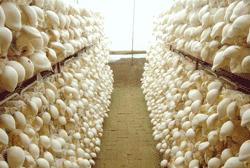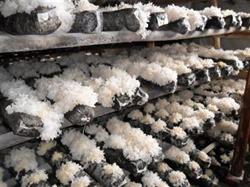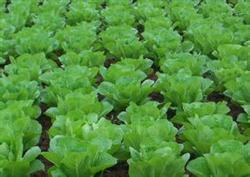A New technique for cultivating Pleurotus ostreatus in whole Plant of Maize

At present, the cultivation of Pleurotus ostreatus is mainly based on cottonseed shell, but it is difficult to develop Pleurotus ostreatus in non-cotton area. Through the experiment, the author found that the biological efficiency of cultivating Pleurotus ostreatus with whole plant of corn can reach 80%-90%, which is equivalent to the yield of cottonseed hull cultivation, and the cost is reduced by about 50%. The main technical points are as follows. 1. Strain production. The original formula: 98% corn kernels, 1% gypsum, 1% sucrose. Boil corn kernels in boiling water for 30 minutes, remove and drain, mix gypsum and sugar, bottle sterilize, insert into mother seed, mycelium grow full bottle and set aside. Cultivation formula: corncob particles 87%, rice bran 10%, gypsum powder 1%, compound fertilizer 1%, lime 1%. The corncobs were soaked in lime water with a pH value of 10: 12 for 12 hours, filtered out and mixed with other excipients. After bottling (bag), sterilization and inoculation, the corncobs were cultured at room temperature for 20-25 days. Mycelium full bottle, white, sturdy, dense after sowing mycelium feed quickly, high yield. 2. Making cultivation bags. Formula: crushed corn straw (0.6-0.8 cm long) 75%, corn kernels 20%, lime 3%, sugar 1%, salt 1%. The corn stalks were exposed to the sun for 2 days, crushed and screened, and the corn kernels were soaked in water for 10 hours and 12 hours. The raw materials of the formula were mixed and mixed with water. The ratio of material to water was 1 ∶ 1.2 ~ 1.4, and the pile was 1.2 ~ 1.5 meters wide, 1 ~ 1.2 meters high and unlimited in length. The material was fermented with plastic film for 7 days. Turn the pile 2 or 3 times during the period, adjust the water content to 60%, and then pack the bag. 3. Sterilization and culture. The diesel cylinder steam was used for local sterilization, and the heat was used for 3-4 hours to keep the temperature in the bag up to 100 ℃ for 16 hours. When the feed temperature dropped to 30 ℃, it was inoculated on the spot. Each bag was put in 40 grams (wet weight) of cultivated seeds, shaded and cultured, doors and windows were closed, and the indoor temperature was controlled at 25 ℃. After 35-40 days, the hyphae can be full of bags, and continue to be cultured for 40 days, so that the hyphae can reach physiological maturity. During the post-ripening period, there should be moderate light stimulation to promote mycelium kink. 4. Mushroom production management. Cultivate good material bags and produce mushrooms in batches. If fresh sale, adopt unbagged vertical soil covering cultivation method; if mushroom processing enterprises purchase, the bigger the mushroom body, the better, the trapezoidal wall soil covering cultivation method can be adopted, and the temperature is controlled at 8 ℃ ~ 20 ℃. Take off the film mulch and grass curtain at night, give low temperature stimulation, and stimulate it with scattered light during the day to promote its budding. The original base in the bag was opened when the soybeans were big, the broad beans were opened when they were big, and the table tennis balls were opened when they were big. The temperature was kept at 12 ℃ ~ 20 ℃, the air relative humidity was 85% and 90%, and the doors and windows were opened and ventilated for 30 minutes every morning and afternoon to keep the air in the shed fresh. 5. Harvest and processing. It takes about 12 days from budding to harvest of Pleurotus ostreatus. Before harvest, stop spraying water for one day and reduce the humidity in the shed to improve the quality of mushrooms. Stop water for 5 days after harvest, clean the mouth of the bag, according to routine management, 2 tide mushrooms can be harvested.
- Prev

How to reduce pollution in Spring Tremella cultivation
The cultivation of Tremella fuciformis in spring is mostly caused by green mold, and some of them are polluted by Rhizopus and Mucor, while Alternaria is rarely. Green mold, Mucor and Rhizopus often occur at the edge of the inoculation hole of the bacterial bag, or when the two-hole bacterial circle joint occurs 10 days after inoculation, it appears in the front of the hyphae and in the bag wall. Green mold also occurs on the fruiting body. Make the ear.
- Next

What should we pay attention to when mixed with foliar fertilizer and pesticides?
1. Choose foliar fertilizer suitable for vegetable varieties to harvest leafball, foliage, young stems and leaves, pay attention to foliar fertilizer rich in nitrogen, and mainly harvest fleshy roots and tubers. Such as radish, potato and so on should choose potassium-rich foliar fertilizer. To harvest fruits, pods and beans.
Related
- Fuxing push coffee new agricultural production and marketing class: lack of small-scale processing plants
- Jujube rice field leisure farm deep ploughing Yilan for five years to create a space for organic food and play
- Nongyu Farm-A trial of organic papaya for brave women with advanced technology
- Four points for attention in the prevention and control of diseases and insect pests of edible fungi
- How to add nutrient solution to Edible Fungi
- Is there any good way to control edible fungus mites?
- Open Inoculation Technology of Edible Fungi
- Is there any clever way to use fertilizer for edible fungus in winter?
- What agents are used to kill the pathogens of edible fungi in the mushroom shed?
- Rapid drying of Edible Fungi

